The Most Beautiful Dragonflies in the World
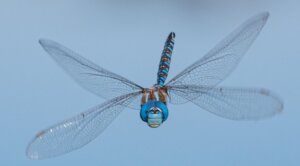

Written and verified by the biologist Cesar Paul Gonzalez Gonzalez
Dragonflies are well known for their curiously elongated appearance and swift flight. In fact, they flap so fast that they seem to hover in the air, almost like hummingbirds. In addition, some beautiful dragonflies sport metallic, iridescent, beautiful and exuberant colorations, which attract everyone’s attention.
The term “dragonfly” is used to designate species belonging to the suborder Anisoptera. This taxonomic group is characterized by small sizes and two pairs of large and showy wings, which can also exhibit bright and eye-catching colorations. Continue reading and discover some of the most beautiful dragonflies in the world.
Differences between dragonflies and damselflies
Before starting with the list, it’s important to point out that in nature there’s another group of organisms that share the physical characteristics of dragonflies. These insects are called damselflies, belong to the suborder Zygoptera and are close relatives of Anisoptera.
Both dragonflies and damselflies belong to the order Odonata. This is the reason why their physical characteristics are so similar. However, they have slight differences that, if one is very observant, serve to easily identify the two groups. Among the features that distinguish each are the following:
- Body width: Dragonflies tend to be stocky, while damselflies are more slender.
- Flapping speed: Dragonflies flap almost twice as fast as damselflies.
- Wing position while resting: Damselflies are able to fold their wings over their abdomen when resting on vegetation, similar to what butterflies do. In contrast, dragonflies are unable to lift their wings over their backs, so they keep them spread.
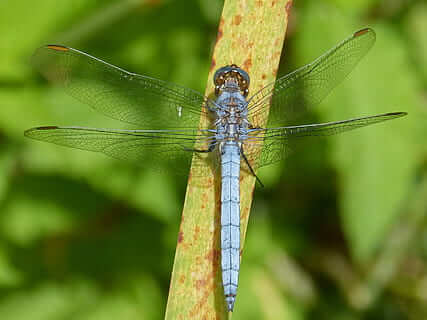
Why are some dragonflies iridescent?
Although flashing colors are often a detrimental feature for animals, dragonflies have transformed them into a beautiful and useful feature for their life. Of course, not all species have iridescent or colorful bodies, but these insects seem to show some preference for such phenotypes.
The habitat of dragonflies consists of open areas with bodies of water and colorful vegetation, which produce certain natural “sparkles” in the sun’s rays. Under these conditions, iridescent or colorful insects have an advantage because they camouflage well with the reflections of the environment. At least this is what’s mentioned in a study published in the scientific journal Journal of Zoology.
The most beautiful dragonflies in the world
It’s a difficult task to select the most beautiful dragonflies in the world, but what we can do is make a list with several that are worthy of the title. Get to know them below.
1. Flame skimmer (Libellula saturata)
This species is easy to identify because it sports a reddish-orange coloration, with wings that combine amber hues and complement its flamed appearance. It tends to be one of the most abundant specimens in North American ponds, streams, lakes and wells, so it isn’t as difficult to find as other types of dragonflies.
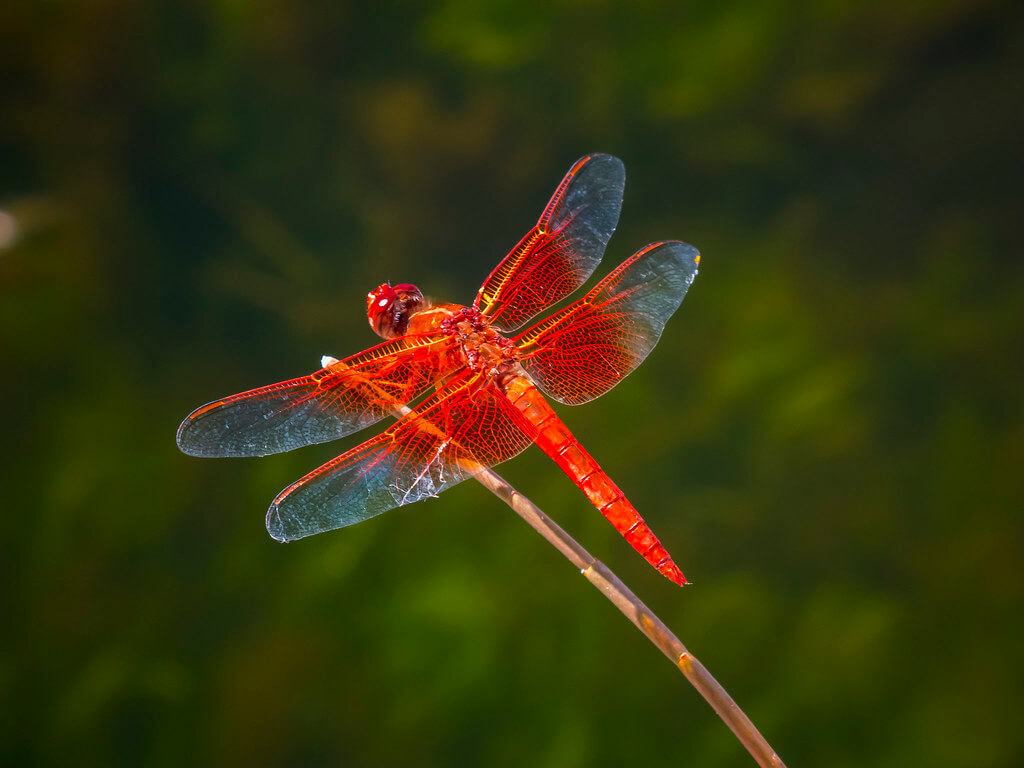
2. The Phantom Flutterer (Rhyothemis semihyalina)
This is perhaps one of the most striking and beautiful dragonflies in the world, as it exhibits metallic colorations combined with black, green, purple and blue tones. In addition, its hind wings have a spot near its body that makes it look even more eye-catching to the naked eye.
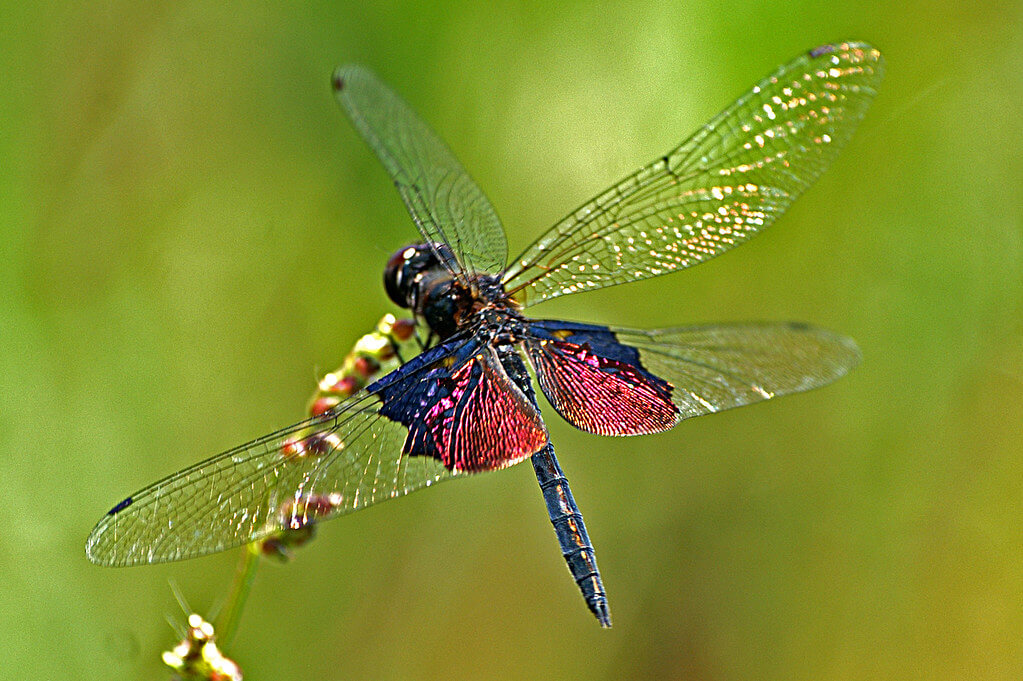
3. Emperor dragonfly (Anax imperator)
The emperor dragonfly gets its name from the fact that it’s the largest species found in Western Europe. Specimens measure around 8 centimeters (just over 3 inches) in length, while their wingspan exceeds 12 centimeters (nearly 5 inches) in length. As if that weren’t enough, they have a coloration that changes according to their sex: green-yellow (females) and blue (males).
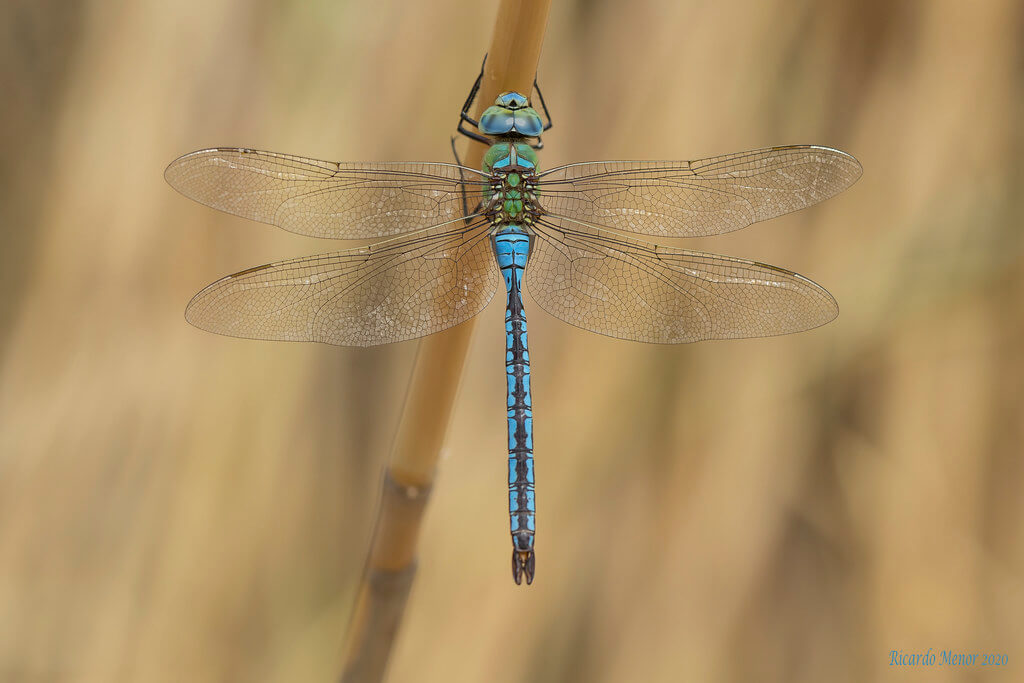
4. Banded darter (Sympetrum pedemontanum)
This curious dragonfly measures between 3 and 4 centimeters long (between 1 and 1.5 inches). It’s characterized by a vibrant red body and a dark band on each wing. Its distribution covers a large part of the Eurasian continent, with records ranging from the Iberian Peninsula to the Kuril Islands.
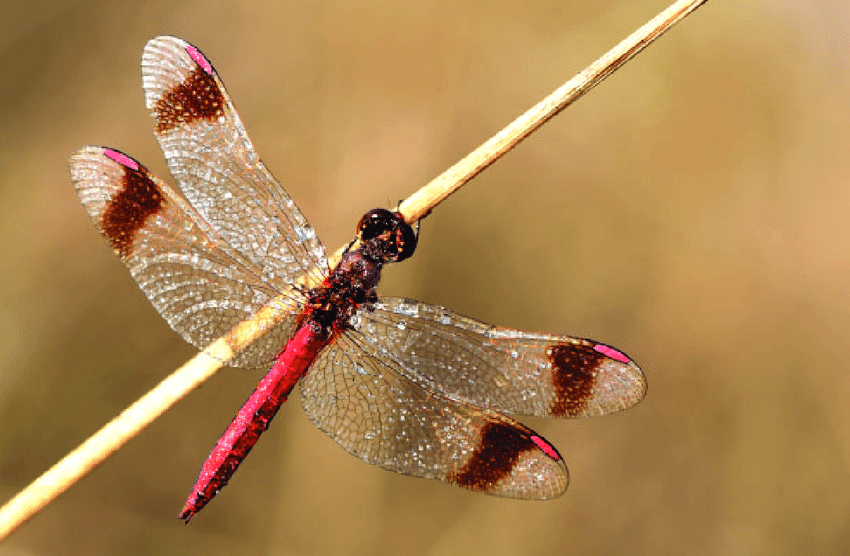
5. Yellow-striped flutterer (Rhyothemis phyllis)
The yellow-striped flutterer dragonfly is an interesting species that breaks somewhat with the traditional odonate appearance. Although it has a dark body, its wings exhibit several bright black and yellow hues that make it stand out among the vegetation.
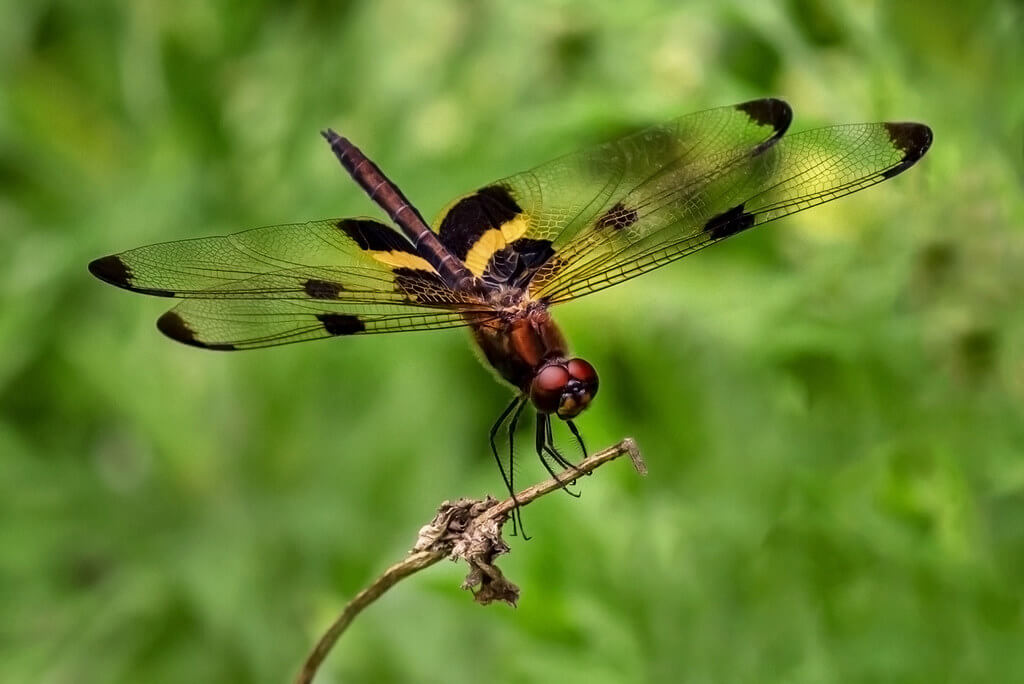
6. The Asian pintail dragonfly (Acisoma panorpoides)
As its name suggests, this species of dragonfly is characterized by an elongated body that becomes thinner towards the tail. Despite its appearance, its dorsum has a striking mottled coloration that combines dark tones with blue spots. However, it can only be found on the Indo-Asian continent.
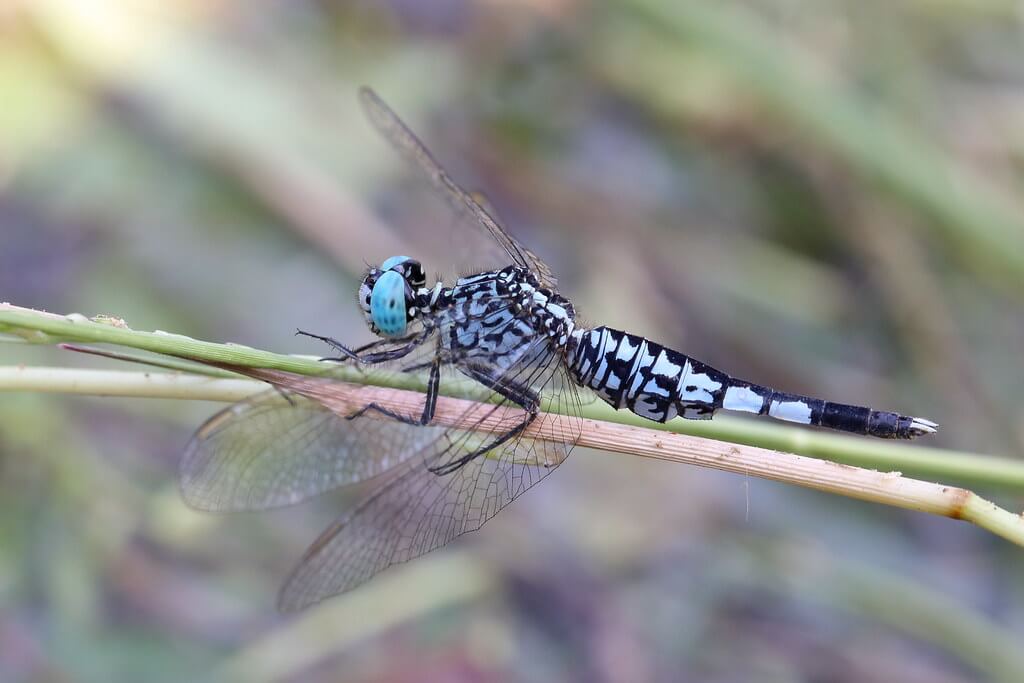
7. Bladetail dragonfly (Lindenia tetraphylla)
The bladetail dragonfly is a peculiar species distributed in Asia and some Mediterranean regions. It’s known for having a sword-shaped tail and a yellow coloration with black spots along its body. While it’s true that its appearance isn’t so dazzling, its color pattern appears brindle, which is quite striking.
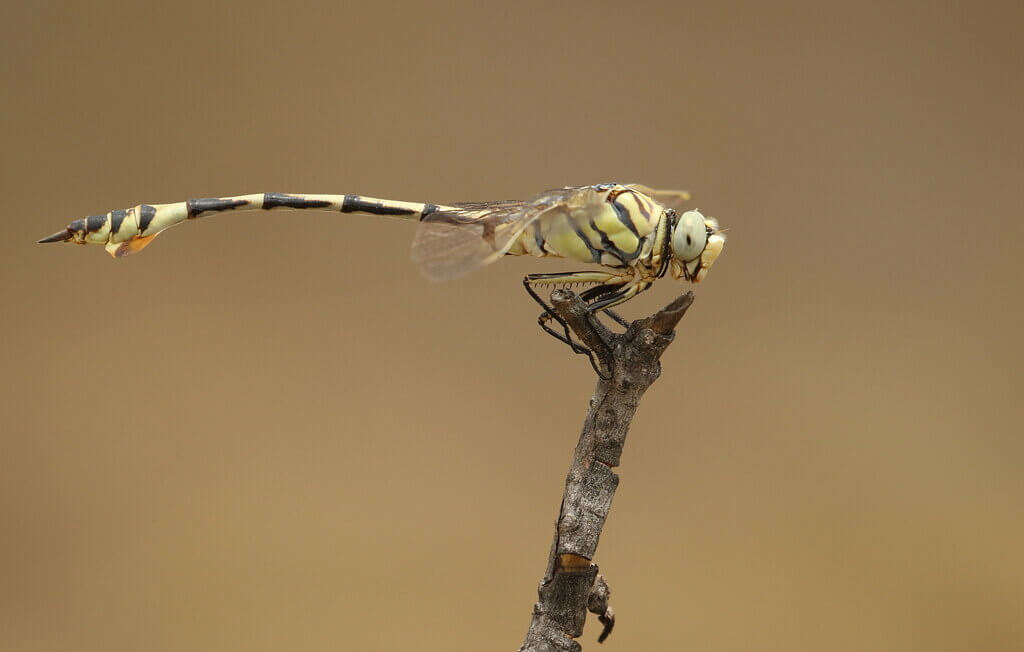
8. Roseate skimmer (Orthemis ferruginea)
This species of dragonfly is so named because it has a pink-violet coloration with black spots, so it’s easy to observe in its environment. It has a wide distribution in the Americas and is a frequent inhabitant of temporary ponds and puddles.
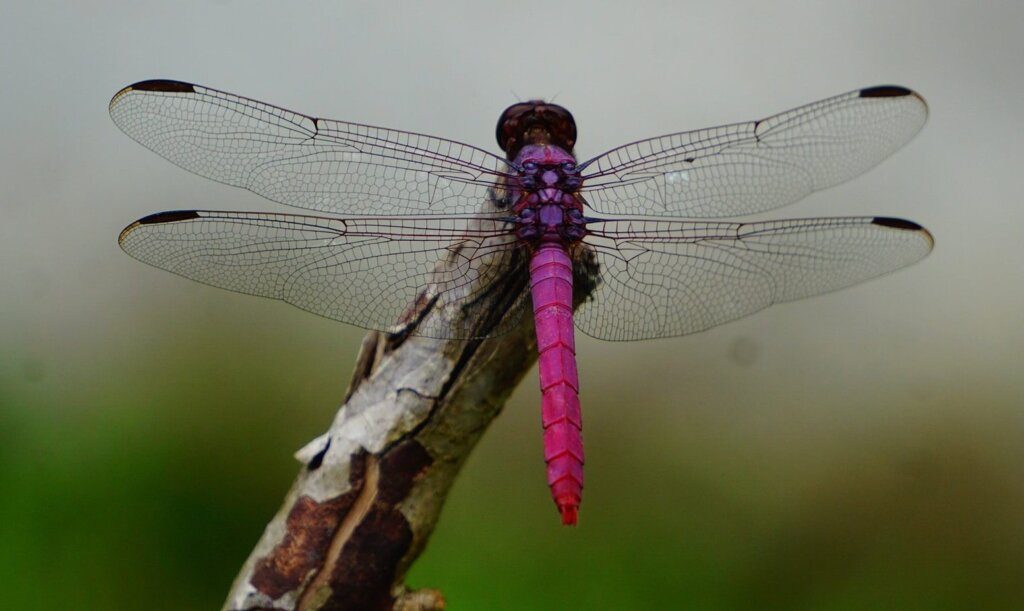
9. Green-eyed hawker (Aeshna isoceles)
This small species is one of the most beautiful dragonflies in the world due to its bright golden-yellow coloration. However, it also has beautiful green eyes that contrast with its body and enhance its beauty. It can be easily found in the Mediterranean, but its distribution covers both Europe and North Africa.
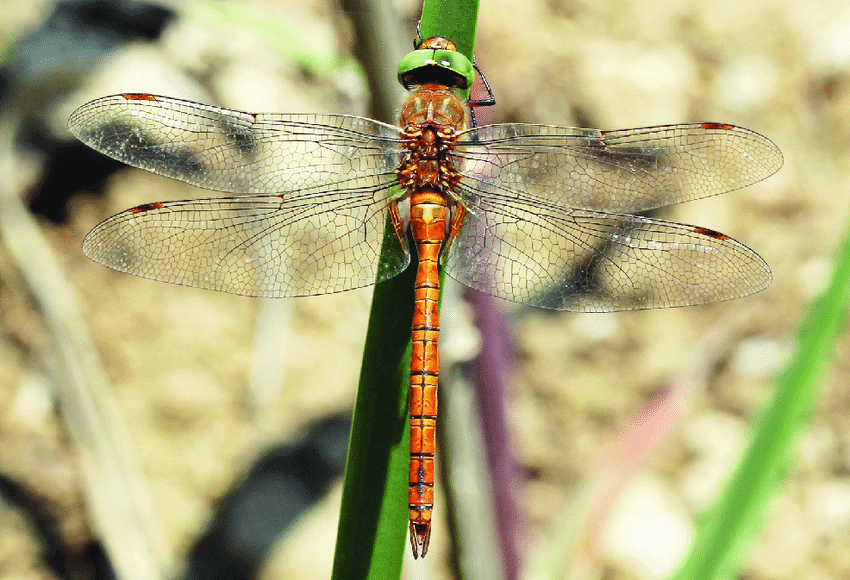
As you can see, there’s a great variety of dragonfly species that deserve to be part of the most beautiful dragonflies in the world. Of course, it’s almost impossible to name them all, but with these examples, it’s clear that extraordinary beauty can be seen in even the tiniest animals, such as insects.
Dragonflies are well known for their curiously elongated appearance and swift flight. In fact, they flap so fast that they seem to hover in the air, almost like hummingbirds. In addition, some beautiful dragonflies sport metallic, iridescent, beautiful and exuberant colorations, which attract everyone’s attention.
The term “dragonfly” is used to designate species belonging to the suborder Anisoptera. This taxonomic group is characterized by small sizes and two pairs of large and showy wings, which can also exhibit bright and eye-catching colorations. Continue reading and discover some of the most beautiful dragonflies in the world.
Differences between dragonflies and damselflies
Before starting with the list, it’s important to point out that in nature there’s another group of organisms that share the physical characteristics of dragonflies. These insects are called damselflies, belong to the suborder Zygoptera and are close relatives of Anisoptera.
Both dragonflies and damselflies belong to the order Odonata. This is the reason why their physical characteristics are so similar. However, they have slight differences that, if one is very observant, serve to easily identify the two groups. Among the features that distinguish each are the following:
- Body width: Dragonflies tend to be stocky, while damselflies are more slender.
- Flapping speed: Dragonflies flap almost twice as fast as damselflies.
- Wing position while resting: Damselflies are able to fold their wings over their abdomen when resting on vegetation, similar to what butterflies do. In contrast, dragonflies are unable to lift their wings over their backs, so they keep them spread.

Why are some dragonflies iridescent?
Although flashing colors are often a detrimental feature for animals, dragonflies have transformed them into a beautiful and useful feature for their life. Of course, not all species have iridescent or colorful bodies, but these insects seem to show some preference for such phenotypes.
The habitat of dragonflies consists of open areas with bodies of water and colorful vegetation, which produce certain natural “sparkles” in the sun’s rays. Under these conditions, iridescent or colorful insects have an advantage because they camouflage well with the reflections of the environment. At least this is what’s mentioned in a study published in the scientific journal Journal of Zoology.
The most beautiful dragonflies in the world
It’s a difficult task to select the most beautiful dragonflies in the world, but what we can do is make a list with several that are worthy of the title. Get to know them below.
1. Flame skimmer (Libellula saturata)
This species is easy to identify because it sports a reddish-orange coloration, with wings that combine amber hues and complement its flamed appearance. It tends to be one of the most abundant specimens in North American ponds, streams, lakes and wells, so it isn’t as difficult to find as other types of dragonflies.

2. The Phantom Flutterer (Rhyothemis semihyalina)
This is perhaps one of the most striking and beautiful dragonflies in the world, as it exhibits metallic colorations combined with black, green, purple and blue tones. In addition, its hind wings have a spot near its body that makes it look even more eye-catching to the naked eye.

3. Emperor dragonfly (Anax imperator)
The emperor dragonfly gets its name from the fact that it’s the largest species found in Western Europe. Specimens measure around 8 centimeters (just over 3 inches) in length, while their wingspan exceeds 12 centimeters (nearly 5 inches) in length. As if that weren’t enough, they have a coloration that changes according to their sex: green-yellow (females) and blue (males).

4. Banded darter (Sympetrum pedemontanum)
This curious dragonfly measures between 3 and 4 centimeters long (between 1 and 1.5 inches). It’s characterized by a vibrant red body and a dark band on each wing. Its distribution covers a large part of the Eurasian continent, with records ranging from the Iberian Peninsula to the Kuril Islands.

5. Yellow-striped flutterer (Rhyothemis phyllis)
The yellow-striped flutterer dragonfly is an interesting species that breaks somewhat with the traditional odonate appearance. Although it has a dark body, its wings exhibit several bright black and yellow hues that make it stand out among the vegetation.

6. The Asian pintail dragonfly (Acisoma panorpoides)
As its name suggests, this species of dragonfly is characterized by an elongated body that becomes thinner towards the tail. Despite its appearance, its dorsum has a striking mottled coloration that combines dark tones with blue spots. However, it can only be found on the Indo-Asian continent.

7. Bladetail dragonfly (Lindenia tetraphylla)
The bladetail dragonfly is a peculiar species distributed in Asia and some Mediterranean regions. It’s known for having a sword-shaped tail and a yellow coloration with black spots along its body. While it’s true that its appearance isn’t so dazzling, its color pattern appears brindle, which is quite striking.

8. Roseate skimmer (Orthemis ferruginea)
This species of dragonfly is so named because it has a pink-violet coloration with black spots, so it’s easy to observe in its environment. It has a wide distribution in the Americas and is a frequent inhabitant of temporary ponds and puddles.

9. Green-eyed hawker (Aeshna isoceles)
This small species is one of the most beautiful dragonflies in the world due to its bright golden-yellow coloration. However, it also has beautiful green eyes that contrast with its body and enhance its beauty. It can be easily found in the Mediterranean, but its distribution covers both Europe and North Africa.

As you can see, there’s a great variety of dragonfly species that deserve to be part of the most beautiful dragonflies in the world. Of course, it’s almost impossible to name them all, but with these examples, it’s clear that extraordinary beauty can be seen in even the tiniest animals, such as insects.
All cited sources were thoroughly reviewed by our team to ensure their quality, reliability, currency, and validity. The bibliography of this article was considered reliable and of academic or scientific accuracy.
- Futahashi, R. (2020). Diversity of UV reflection patterns in Odonata. Frontiers in Ecology and Evolution, 8, 201.
- Minot, M., Besnard, A., & Husté, A. (2021). Habitat use and movements of a large dragonfly (Odonata: Anax imperator) in a pond network. Freshwater Biology, 66(2), 241-255.
- Popova, O. N. (2004). Infraspecific taxonomy of Sympetrum pedemontanum (Müller, 1766)(Anisoptera: Libellulidae). Odonatologica, 33(2), 207-216.
- Lockwood, M. (2007). Rediscovery of Sympetrum pedemontanum (Müller in Allioni) and S. vulgatum (L.) in Catalonia, NE Spain (Anisoptera: Libellulidae). Notulae odonatologicae, 6(10), 115-118.
- Misof, B. (2002). Diversity of Anisoptera (Odonata): infering speciation processes from patterns of morphological diversity. Zoology, 105(4), 355-365.
- Rüppell, G. (1989). Kinematic analysis of symmetrical flight manoeuvres of Odonata. Journal of experimental Biology, 144(1), 13-42.
- Prum, R. O., Cole, J. A., & Torres, R. H. (2004). Blue integumentary structural colours in dragonflies (Odonata) are not produced by incoherent Tyndall scattering. Journal of Experimental Biology, 207(22), 3999-4009.
- Ramírez, A. (2010). Capítulo 5: Odonata. Revista de Biología tropical, 58, 97-136.
- Heckman, C. W. (2006). Encyclopedia of South American aquatic insects: Odonata–Anisoptera: Illustrated keys to known families, genera, and species in South America. Dordrecht: Springer Netherlands.
This text is provided for informational purposes only and does not replace consultation with a professional. If in doubt, consult your specialist.








